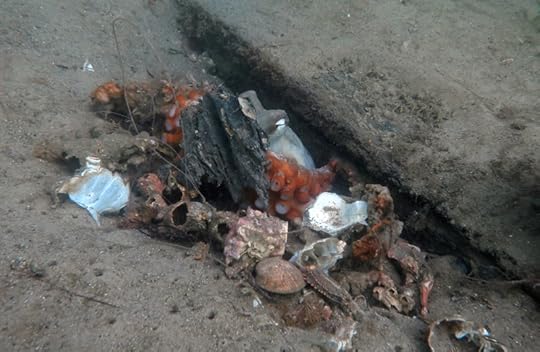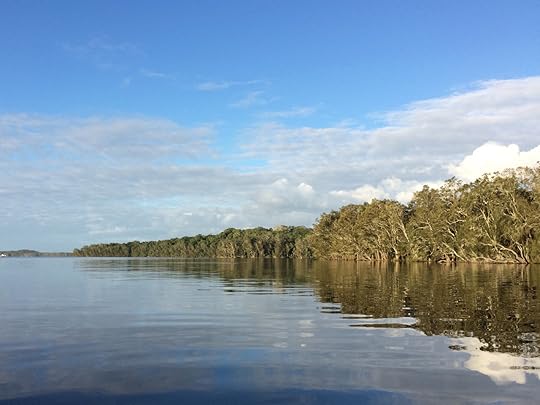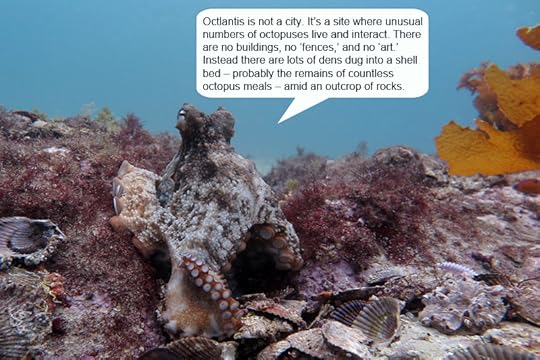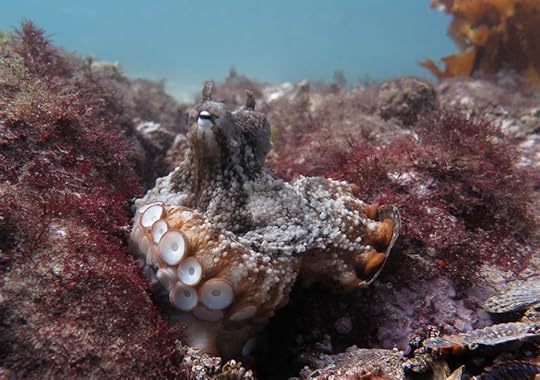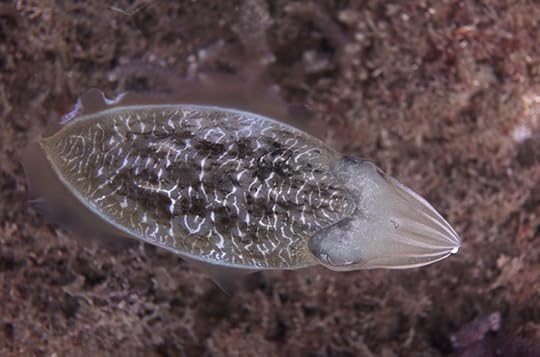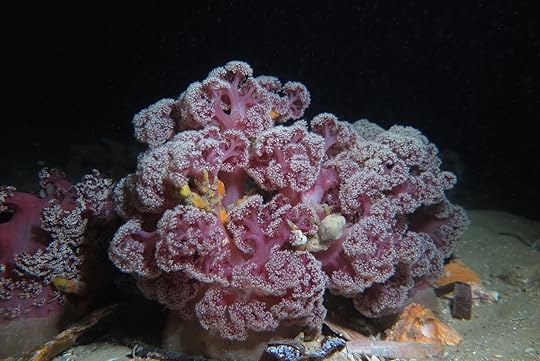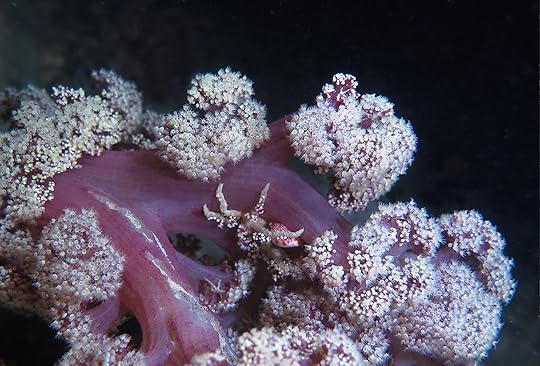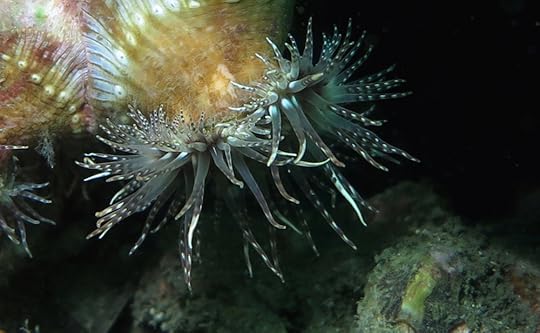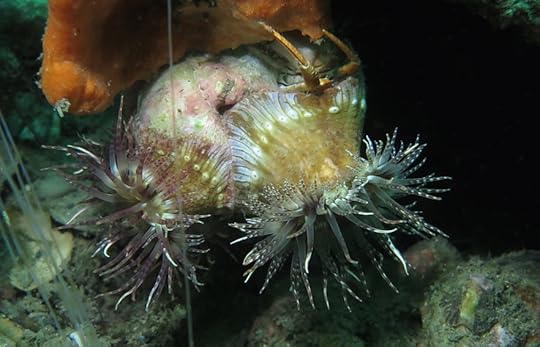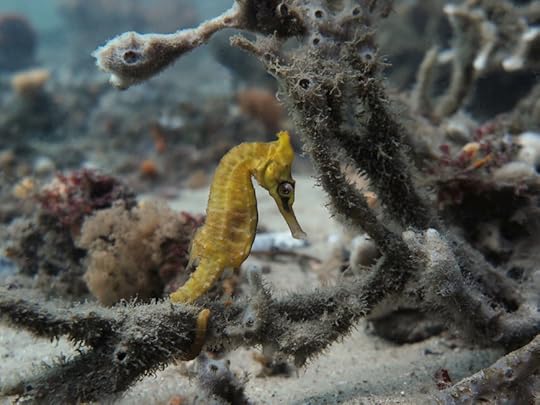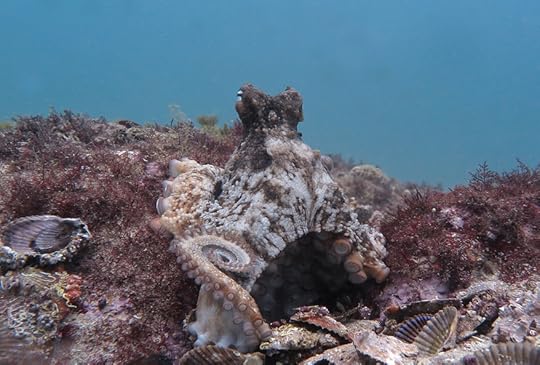Peter Godfrey-Smith's Blog, page 8
December 25, 2017
57. Octopus Intentions
What do we have here? Various bits of body – some lobster, I think, on the left; a clam shell; a bit of crab claw and crab carapace. Arrayed in the front are what look like the remains of barnacles (not usually octopus food), some fishing line, scraps of algae. And in the middle above the barnacles, held there by the octopus, a black object that looks like an old bit of wood.
The octopus was at Chowder Bay, a great place for collecting, if you are an octopus. I’ve been reminded of dens like...
November 20, 2017
56. Land and Sea
An unexplained terrestrial incursion by several dozen octopuses, walking onto the shore in Wales a fews ago, reminded me of a plan to write something on this site about the relations between life on land and in the sea.
The early stages of animal evolution all took place in the sea. Animals began to come onto land something like 450 million years ago, in the Ordovician. Arthropods were the first, and different members of that group made their way onto land something like seven separate time...
October 12, 2017
55. Octlantis Media
Last month our latest octopus paper appeared, describing a new site where octopuses live in unusually large numbers. We call the site, which was discovered last year, “Octlantis.” Soon after it appeared, the paper was picked up by the media, especially by popular science websites. Initially the stories were reasonably accurate, with just a little picturesque exaggeration, but some of them soon began to get out of hand. There are now articles about the site that claim the octopuses are “makin...
September 9, 2017
54. Octlantis
About eight years ago now, my friend Matt Lawrence discovered the site we call “Octopolis,” and since then it’s been an important part of my underwater explorations and a regular feature on this website. Octopolis, as the name suggests, is notable for its high density of octopuses – there can be up to 16 present in a small area, though more often it’s half a dozen or so. The occupied area is roughly centered on what looks like an old human-made object, perhaps dropped off a boat many years a...
August 29, 2017
53. Grains of Sand
This post is photographic and miscellaneous, one that marks time before some octopus-related news I’ll have on this website in week or two (when an article has gone through the press). In the meantime I’ve been diving in the winter water of Nelson Bay and Fairlight, so here are some shots of animals at different spatial scales.
The one above is a cuttlefish (Sepia plangon) showing some black Jackson Pollock scribbles. Below is an Armina sniffing through a horizontal cluster of tree-like poly...
July 16, 2017
52. A Night at the Pipe
Last week I went for a night dive at “the Pipeline,” in Nelson Bay, with Dave Harasti, who has dived, studied, and helped protect the area for over a decade. This post is photographic, a record of the dive’s creatures.
The area where we spent most of our time was a little away from the main site, a field of soft coral. Those corals are teeming with small animals – cowrie shells, decorator crabs who start out clothed in coral before graduating to sponges…
… so much small-scale life that it w...
June 15, 2017
51. Metafauna
Something in a cluster of life caught my eye while diving at Nelson Bay a while back. I went in to look, and it was an anemone. As I watched, it ambled slowly away.
It says something about the effects of breathing high-pressure air that my first nitrogenated thought was: ‘OK, I guess some anemones can walk.’ A closer look showed what was going on.
The photo above reveals a couple of legs, and the one below shows the whole combination. The anemone was being carried by a Hermit Crab, probably...
May 28, 2017
50. Points of View
The photo was taken at Nelson Bay. It is a White’s seahorse (Hippocampus whitei). They seem so delicate that in the water I have become quite concerned not to disturb them. I never take seahorse photos now with added light, making do only with what is available. This one seemed to repay my concern. Often, when you are watching a seahorse, if you come round the front of them they will slowly turn away, to face directly or nearly directly away from you. In some ways, this must leave them even...
April 26, 2017
49. The Edited Octopus
This has been a big month for cephalopod genetics, due to a paper in the journal Cell by Noa Liscovitch-Brauer and co-authors, reporting that octopuses and other “coleoid” cephalopods (cuttlefish, squid) engage in some unusual “editing” of the RNA in their cells. [1]
The usual rough picture is that DNA is “transcribed” to make RNA and then the sequence of units (nucleotides) in the RNA specifies the sequence of units (amino acids) in a protein. But the RNA in many organisms is “edited” – mod...
49. The Editorial Octopus
This has been a good month for cephalopod genetics, due to a paper in the journal Cell by Noa Liscovitch-Brauer and co-authors, reporting that octopuses and other “coleoid” cephalopods (cuttlefish, squid) engage in some unusual “editing” of the RNA in their cells. [1]
The usual rough picture is that DNA is “transcribed” to make RNA and then the sequence of units (nucleotides) in the RNA specifies the sequence of units (amino acids) in a protein. But the RNA in many organisms is “edited” – mo...
Peter Godfrey-Smith's Blog
- Peter Godfrey-Smith's profile
- 685 followers


